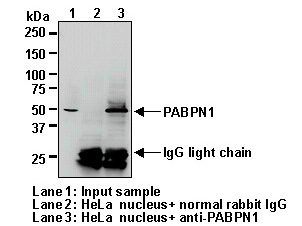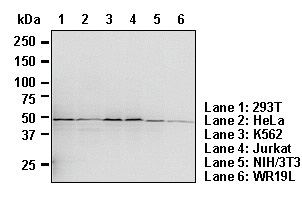Anti-PABPN1 (Human) pAb
| Code | Size | Price |
|---|
| MBL-RN023PW | 100 ul | £323.00 |
Quantity:
Prices exclude any Taxes / VAT
Overview
Host Type: Rabbit
Antibody Isotype: Affinity Purified Ig
Antibody Clonality: Polyclonal
Regulatory Status: RUO
Target Species:
- Human
- Mouse
Applications:
- Immunoprecipitation (IP)
- Western Blot (WB)
Shipping:
4°C
Storage:
-20°C
Images
Documents
Further Information
Applications:
WB - 1 ug/mL for chemiluminescence detection system IP - 5 ug/500 uL of cell extract from
5 x 106 cells
Background:
In mammals, the proteins of the poly (A)-binding protein (PABP) family exist in several cytoplasmic forms and one nuclear isoform, and these proteins are encoded by different genes. PABP binds to the mRNA poly(A) tail in the cytoplasm and regulates both mRNA stability and translation, while PABPN1 in the nucleus is involved in the synthesis of the poly(A) tail, regulation of the length of newly synthesized poly(A) tail, and stimulating the maturation of mRNA. Immunofluorescence microcopy revealed that PABPN1 is localized throughout the nucleoplasm, with higher concentration in speckles, and that the binding of PABPN1 to poly(A) tails is essential for its localization to the speckles. It has been reported that PABPN1 binds to the RNA polymerase II before, at the start of, or shortly after the initiation of transcription; therefore, the assembly of PABPN1 onto the poly(A) tail may be coupled with transcription. Abnormal expansion of a (GCG)6 trinucleotide repeat at the 5? end of the coding region of PABPN1 gene may lead to autosomal dominant oculopharyngeal muscular dystrophy (OPMD). Intranuclear inclusions of PABPN1 may play important roles in the pathogenesis of this disease, since the deletion of the C-terminal oligomerization domain in PABPN1 inactivates its oligomerization and reduces cell death.
Concentration:
1 mg/mL
Formulation:
100 ul volume of PBS containing 50% glycerol, pH 7.2. No preservative is contained.
Gene IDs:
Human: 8106 Mouse: 54196
Immunogen Translated:
Internal region synthetic peptide binding KLH, human PABPN1
Reactivity:
This antibody reacts with human and mouse PABPN1 on Western blotting and Immunoprecipitation.
Shelf Life:
1 year
Source:
This antibody was purified from rabbit serum by affinity column chromatography. The rabbit was immunized with KLH conjugated synthetic peptide, corresponding to internal region of human PABPN1.
Target:
PABPN1
References
1)
Hino, H., et al., Hum. Mol. Genet. 13, 181-190 (2004)
2)
Mangus, D. A., et al., Genome Biol. 4, 223 (2003)
3)
Bear, D. G., et al., Exp. Cell Res. 286, 332-334 (2003)
4)
Calado, A., and Carmo-Fonseca, M., J. Cell Sci. 113, 2309-2318 (2000)






